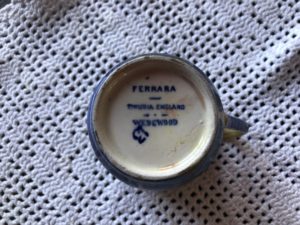Harasimowicz’s book “Saga czyli filiżanka, której nie ma” (Saga or the cup that isn’t there) about his family history was inspired by his mother’s memory of a cup. In the Pawłowicz family lore, another cup features prominently. Not the phantom cup of a Napoleonic soldier, but a tangible piece of a china coffee service in Warsaw that belonged to my great-grandmother Helena.


Around 1913, it likely resided in the Pawłowicz house on Kanonia 14 in the Old Town. Later, around 1925, as the family expanded, it found a new home in Kazimierz Pawłowicz’s newly built house on Goraszewska 8 in City Garden Czerniaków (Sadyba). The cup survived World War II after the Nazis destroyed the family houses and possibly made its way from Poland to Sweden in 1946, where my great-grandmother traveled. From then onwards, the cup became a cherished piece of memorabilia with its own story.
It is unclear whether Helena found it or if someone else retrieved it and gave it to her before she left Poland forever. The family narratives do not mention when and how it was recovered from the debris on Goraszewska 8. In any case, it crossed the Atlantic Ocean—perhaps first to Rio de Janeiro, Brazil, where it joined Bohdan Pawłowicz and his family. Subsequently, it accompanied the family to the U.S., residing in various households
When my great-grandmother passed away in 1962, her daughter-in-law (my grandmother), Wanda, took care of the cup until it returned to Brazil. It was displayed on a glass shelf in my mother’s home in Santos, sparking questions about its origin and significance. Unfortunately, at my place in the countryside, it met its demise when it dropped and shattered into pieces. The cup is no more. Fortunately, I had managed to photograph it earlier, and the images above now bear witness to its existence. This short post attests to the memory it embodied for three generations of women before me—a memory of a world that no longer exists.
Regarding the questions asked when the cup was on display, the explanation given was that this old and charred china coffee cup became the sole remnant of the Pawłowicz household in Poland. It was salvaged from the rubble and ashes where the house on Goraszewska 8 once stood. The house was destroyed sometime after the Warsaw Uprising in November 1944, as retaliation when an informant told the Germans that Helena had buried guns and uniforms of Home Army (Armia Krajowa) soldiers in the garden.
Although the house on Kanonia 14 was rebuilt after the war as part of the reconstruction of Warsaw’s Old Town, it was nationalized by the Soviet regime, and later its ownership was transferred to the Warsaw municipality. The vacant and leveled plot of land on Goraszewska 8 in Czerniaków, where the Pawłowicz family house once stood, became a public square.”
